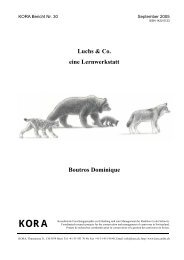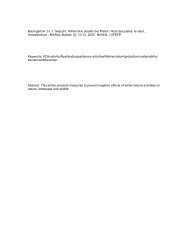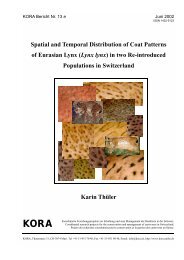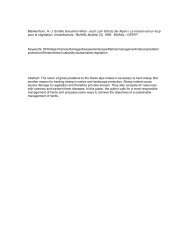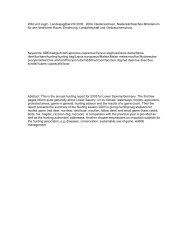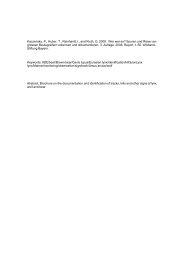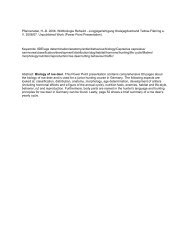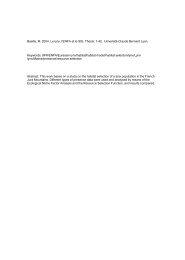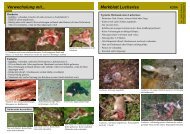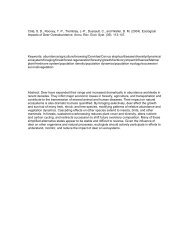im saisonalen Verlauf - Kora
im saisonalen Verlauf - Kora
im saisonalen Verlauf - Kora
Erfolgreiche ePaper selbst erstellen
Machen Sie aus Ihren PDF Publikationen ein blätterbares Flipbook mit unserer einzigartigen Google optimierten e-Paper Software.
6 SummaryThe digestibility of slowly fermentable/digestible plant material increases withincreasing particle retention t<strong>im</strong>e in the forestomach of ruminants. The retentiont<strong>im</strong>e in the gastro-intestinal-tract depends on the size of the fermentationchambers, the food intake, the saliva flow and the selective retention of foodparticles. The mean retention t<strong>im</strong>e (MRT) of fluid and particles should differbetween ruminant species and, according to differences in food quality andavailability, between seasons. By measuring the ingesta passage rate of roe deer,a concentrate selector, in comparison with mouflon, a grass and roughage eater,adaptation factors of these different species to the seasonally changing foragesupply were investigated.A prerequisite for the trials was the habituation of the wild an<strong>im</strong>als to the humaninvestigator. Four roe deer fawns and five mouflon lambs were hand-raised with acommercial milk replacer. Rumen fistulas were <strong>im</strong>planted in all adult an<strong>im</strong>alsleading to the dorsal ruminal chamber. The an<strong>im</strong>als were kept in adequateenclosures with natural vegetation. Roe deer fawns and mouflon lambs of two ageclasses were bottle-fed with a fluid marker (Cr-EDTA); monthly, for 15 months, afluid (Co-EDTA) and a particle (Cr-mordanted fibre) marker were applied to alladult an<strong>im</strong>als via the rumen fistula. After marker application, faecal samples werecollected every 4 hours for 5 days. Faecal samples were prepared according to anewly developed method with sulphuric acid. The Co- and Cr-concentrations weremeasured by atomic absorption spectrophotometry. The retention t<strong>im</strong>e of fluid andparticle phase in the gastro-intestinal-tract were calculated according toThielemans et al. (1978), Grovum und Williams (1973) und Lechner-Doll (1990).Such investigations were carried out for the first t<strong>im</strong>e under natural conditionscomparing roe deer (n = 2) and mouflons (n = 5), and yielded the following results:1. In young an<strong>im</strong>als, the ingestion of plant material and the daily faecalvolume increased with increasing age up to the point of weaning,leading to a reduction of ingesta retention t<strong>im</strong>e distal of thereticulorumen.2. The total retention t<strong>im</strong>e of fluid and particles in the gastro-intestinaltractwas, for roe deer (MRT fluid GIT = 18,1 ± 2,4 h, MRT part.GIT = 23,6± 3,8 h) shorter than for mouflon (MRT fluid GIT = 22,5 ± 3,9 h,MRT part.GIT = 36,0 ± 4,2 h ) during the whole year. The particleretention t<strong>im</strong>e in the reticulorumen was for roe deer MRT part.RR = 13,9± 3,1 h and for mouflon MRT part.RR = 24,8 ± 3,0 h. Fluid remained inthe reticulorumen of roe deer for MRT fluid RR = 8,0 ± 1,0 h and ofmouflon for MRT fluid RR = 11,5 ± 2,0 h.3. For both species, the ingesta retention t<strong>im</strong>e in the gastro-intestinaltractshowed significant seasonal fluctuations. They were shorterduring autumn, when the an<strong>im</strong>als showed an increased food intake,and longer in winter due to a reduction in both metabolic rate andingestion of forage of low digestibility.96



